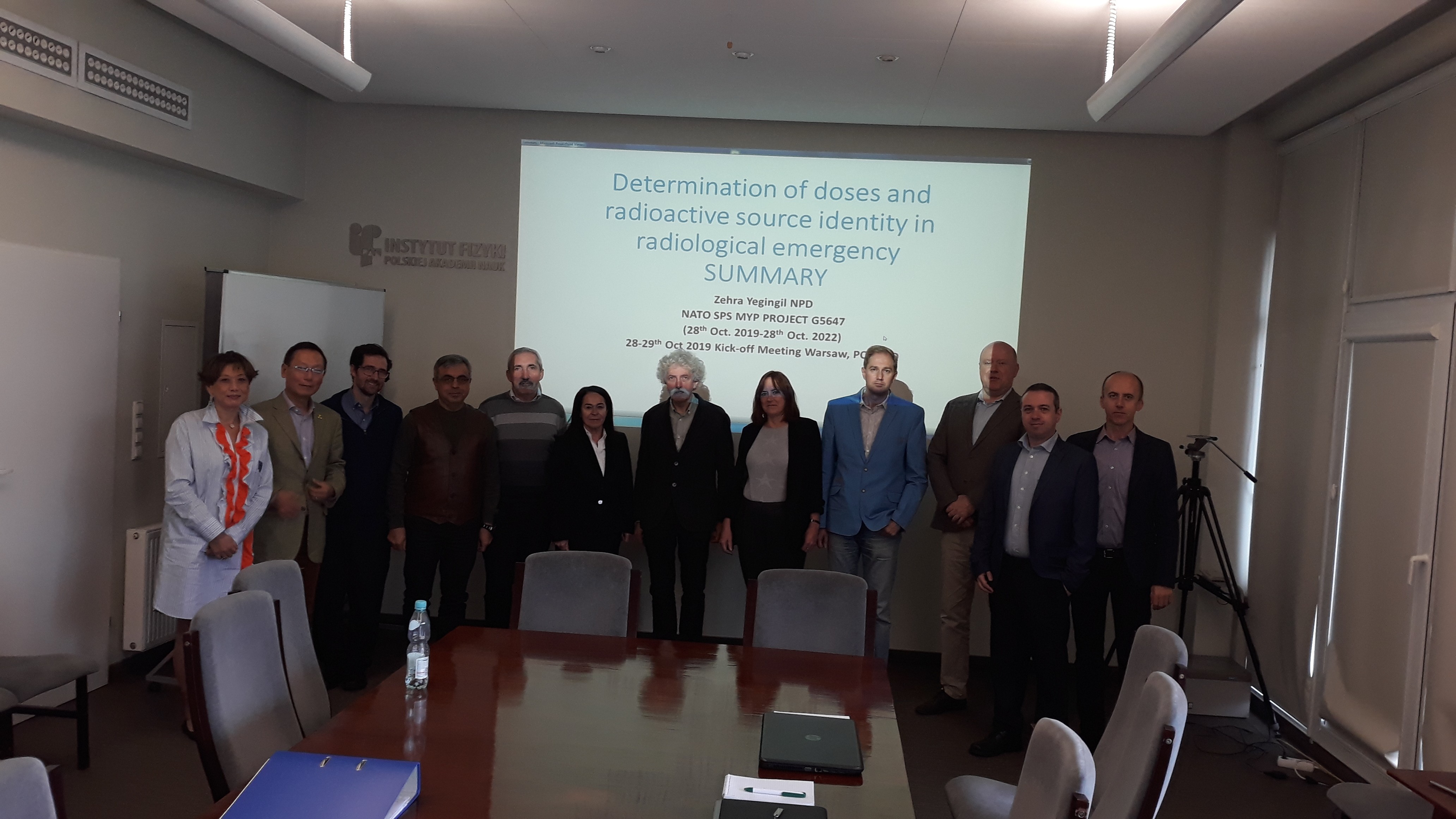NATO new project kickoff meeting summary
Determination of exposed dose and radioactive source identity in radiological emergency
SPS G5647
Warsaw Oct 28th, 2019
Participants
Prof.Dr. Zehra Yegingil
|
Cukurova University
|
TURKEY
|
NPD
|
Dr. MBBS MA MRCP Yaacov Richard Lawrence
|
Sheba Medical Center
|
ISRAEL
|
PPD
|
Prof.Dr. Yan Yu
|
Thomas Jefferson University Hospital
|
USA
|
Co-Director
|
Prof.Dr. Sergii Ubizskii
|
Lviv Polytechnic National University
|
UKRAINE
|
Co-Director
|
Ph.D., D.Sc. Vadim Chumak
|
Radiation Protection Institute, Academy of Technological Sciences of Ukraine
|
UKRAINE
|
Co-Director
|
Prof.Dr.Kasim Kurt
|
Mersin University
|
TURKEY
|
Co-Director
|
D.Sc. Prof. Yaroslav Zhydachevskyy
|
Institute of Physics of the Polish Academy of Sciences (PAS)
|
POLAND
|
Co-Director
|
Prof.Dr.Wei Gao
|
The University of Auckland
|
NEW ZEALAND
|
Co-Director
|
Zehra Yegingil – Introduction to the meeting
Previous NATO project 11.11.2014-10.6.2018 sfp984649
- We had regular 6 meetings
- Two groups of materials – low Z and high Z
- BeO:Ca,Al
- YAIO3:Mn2+
- Badges and OSL reader
- The idea developed that a combination of high and low Z can be used to determine radionucleotide.
- NATO suggested that the project is renewed.
- Publications – from different groups
- Applied for Patent (and obtained?)
New project overview, Zehra Yegingil 2019 –
Determination of exposed dose and radioactive source identity in radiological emergency
- Discussed the various members
- All in previous the project, 3 changes
- Gao from NZ – an expert in nanostructures
- Yaroslav is now a full co-director at IFPAS Poland
- Sergei Ubizskii will create OSL reader
- There are 3 components to the emergency dosimeter
- Luminescent material
- Casing + special filters
- The reader
Sergei Ubizskii, Lviv – the new project (came with Andrie Luchechko Ph.D.)
- Design of OSL reader,
- Previous project -YAP:Mn characterize as a thermo-luminescent crystal
- Also, they have developed a reader (was not a formal part of the previous project)
- New aim - To develop a reader suitable for both YAP:Mn and BeO
Discussed three options:
- Dosimeter with two materials (high Z and low Z) – this requires a complex reader
- One material (high Z) with different thicknesses
- One material with different filters [less practical]
Vadim Chumak, Ukraine
- Energy dependency of thermoluminescence can be seen as a disadvantage or advantage since it allows to determine the energy composition of spectrum
- With added filter can modify the energy response and make it more meaningful
Yaroslav Zhydachevskyy - Warsaw
- High Z phosphor OSL dosimetry
- Aim to further improve the material by adding Lu
- Three research groups
- Oxide crystals (IP PAS Warsaw)
- High-pressure spectroscopy (IP PAS Warsaw)
- Dep radiation physics and dosimetry (INP PAS Cracow)
Yaacov Lawrence and Sergey Dubinski, Sheba
- Medical need related to types of a radiological accident
- Importance of radionucleotide detection
- Types of irradiator
- Discussion – need to determine the spectrum of kilovoltage machine
- Two things that could be done and have not been done yet
- Blind irradiation and have the Turkish/Ukrainian groups determine dose/source
- Use the new dosimeter in the clinical setting
Yan Yu, Jefferson
- Lots of unknowns
- R = xADA + xBDB
- Therefore, need lots of data points, and the spectrum of test beams needs to be precisely known
- Budget no longer covers radionucleotide seeds
- (8 seeds for each data the point, for each sample)
- Now replace seeds with low energy X rays from the mammography unit, different manufactures use different target materials
- Possible new end-user – patient dose-tracking in diagnostic procedures (under discussion at AAPM) throughout a patient’s life
- Vadim’s comments: discussion of issues related to shipping samples, irradiation by the post office. Possibility of having reader at the place of irradiation
Kasım Kurt, Mersin University
- Develop Optical Luminescent Instrument / Reader
- Now using spectrometers
- Discussion regarding technical aspects of the reader design
- Risks – luminesce signal not bright enough, also emission signal very short - < 2ms-
- Solution: try to detect with single-photon counting
- Can also heat samples
Zehra Yegingil, Cukurova University
- Thermoluminescence lab
- Has worked with several materials over the last five years
- Also has Boron projects ongoing, with patented compounds. But these Boron compounds have fading issues.
- Now focusing on BeO compounds.
- New NATO project will look at BeO, MgO, TiO2, ZnO
- BeO is very poisonous until made into a ceramic
Skype call with Wei Gao in New Zealand
https://unidirectory.auckland.ac.nz/profile/w-gao
- 22 has a large lab with 22 people, mostly PhD
- Works in Nanomaterials, oxides, surface, mechanical, and photo…. properties
- Can makes oxide films
- Maybe can grow Be-oxide with special properties, single crystal, and transparent form.
